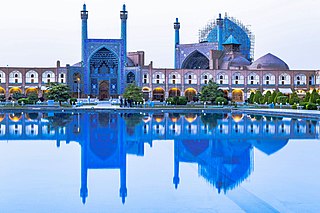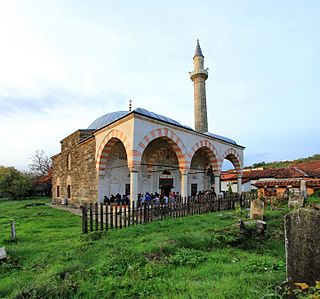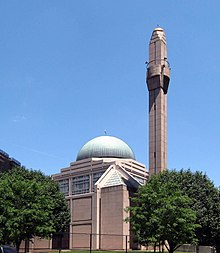
A mosque, also called masjid, is a place of prayer for Muslims. Mosques are usually covered buildings, but can be any place where prayers (sujud) are performed, including outdoor courtyards.

Islamic architecture comprises the architectural styles of buildings associated with Islam. It encompasses both secular and religious styles from the early history of Islam to the present day. The Islamic world encompasses a wide geographic area historically ranging from western Africa and Europe to eastern Asia. Certain commonalities are shared by Islamic architectural styles across all these regions, but over time different regions developed their own styles according to local materials and techniques, local dynasties and patrons, different regional centers of artistic production, and sometimes different religious affiliations.

The Sanctuary of Imām 'Alī, also known as the Mosque of 'Alī, located in Najaf, Iraq, is a mosque which many Muslims believe contains the tomb of 'Alī ibn Abī Tālib, a cousin, son-in-law and companion of the Islamic prophet Muhammad. The Shī'as consider 'Alī as their first Imām, and the Sunnis regard him as the fourth Sunni Rashid Caliph. According to Shī'ite belief, buried next to 'Alī within this mosque are the remains of Adam and Nuh (Noah). Each year, millions of pilgrims visit the Shrine and pay tribute to Imām 'Alī.

Mihrab is a niche in the wall of a mosque that indicates the qibla, the direction of the Kaaba in Mecca towards which Muslims should face when praying. The wall in which a mihrab appears is thus the "qibla wall".

Al-Masjid an-Nabawi, known in English as the Prophet's Mosque, is a mosque built by the Islamic prophet Muhammad in the city of Medina in the Al Madinah Province of Saudi Arabia. It was the second mosque built by Muhammad in Medina, after Quba Mosque, and is the second largest mosque and second holiest site in Islam, both titles ranking after the Masjid al-Haram in Mecca. The mosque is located at the heart of Medina and is a major pilgrimage site that falls under the purview of the Custodian of the Two Holy Mosques.

The Shah Mosque is a mosque located in Isfahan, Iran. It is located on the south side of Naghsh-e Jahan Square. It was built during the Safavid dynasty under the order of Shah Abbas I of Persia.

The holiest sites in Islam are predominantly located in Western Asia. While the significance of most places typically varies depending on the Islamic sect, there is a consensus across all mainstream branches of the religion that affirms three cities as having the highest degree of holiness, in descending order: Mecca, Medina, and Jerusalem. Mecca's al-Masjid al-Haram, Medina's al-Masjid an-Nabawi, and Jerusalem's Temple Mount are all revered by Muslims as sites of great importance.
The Masjid al-Qiblatayn, also spelt Masjid al-Qiblatain, is a mosque in Medina believed by Muslims to be the place where the final Islamic prophet, Muhammad, received the command to change the Qibla from Jerusalem to Mecca. The mosque was built by Sawad ibn Ghanam ibn Ka'ab during the year 2 AH and is one of the few mosques in the world to have contained two mihrabs in different directions.

Dome of the Chain is an Islamic free-standing domed building located adjacently east of the Dome of the Rock in the Old City of Jerusalem. It is one of many small buildings that can be found scattered around the Temple Mount. Its exact historical use and significance are under scholarly debate. Erected in 691-92 CE, the Dome of the Chain is one of the oldest surviving structures on the Temple Mount.

The destruction of heritage sites associated with early Islam is an ongoing phenomenon that has occurred mainly in the Hejaz region of western Saudi Arabia, particularly around the two holiest cities of Islam, Mecca and Medina. The demolition has focused on mosques, burial sites, homes and historical locations associated with the Islamic prophet Muhammad, his companions, and many of the founding personalities of early Islamic history by the Saudi government. In Saudi Arabia, many of the demolitions have officially been part of the continued expansion of the Masjid al-Haram at Mecca and the Prophet's Mosque in Medina and their auxiliary service facilities in order to accommodate the ever-increasing number of Muslims performing the pilgrimage (hajj).

Both Sunni Muslims and Shia Muslims agree on the three holiest sites in Islam being, respectively, the Masjid al-Haram, in Mecca; the Al-Masjid an-Nabawi, in Medina; and the Al Aqsa Mosque compound, in Jerusalem.

The Great Mosque of Mahdiya is a mosque that was built in the tenth century in Mahdia, Tunisia.

Masjid al-Haram, also known as the Great Mosque of Mecca, is a mosque that surrounds the Kaaba in Mecca, in the Mecca Province of Saudi Arabia. It is a site of pilgrimage in the Hajj, which every Muslim must do at least once in their lives if able, and is also the main phase for the ʿUmrah, the lesser pilgrimage that can be undertaken any time of the year. The rites of both pilgrimages include circumambulating the Kaaba within the mosque. The Great Mosque includes other important significant sites, including the Black Stone, the Zamzam Well, Maqam Ibrahim, and the hills of Safa and Marwa.

The Hadum Mosque in Gjakova, Kosovo was built in the last decade of the 16th century (1594/95) and was financed by Hadum Sylejman Efendia – Hadum Aga, which explains the name of the mosque. The mosque was built on the property of Jakë Vula and is located in the Old Bazaar. A rectangular, dome-covered structure, it belongs to the classic forms of mosque of the Islamic-Kosovar style. Around the mosque there are tombs with sculpted decorations and engraved with epithets in the old Ottoman language. The tombs belonged to the most respected families in Gjakova. There also used to be a "hamam", but it was destroyed during World War II. The entrances are covered with floral paintings, geometrical shapes, citations from the Kur'an and arabesques. In 1999, the surrounding complex was burned to the ground and only the mosque and the minaret along with some damaged arabesques survived.

Imam Shamsi Ali is a prominent Indonesian Muslim Scholar known for promoting interfaith dialogues among Abrahamic Religions in United States and the Chairman of the Al-Hikmah Mosque and the Director of Jamaica Muslim Center in Jamaica, Queens, New York City.

The Shah Mosque, also known as the Soltāni Mosque meaning "royal", renamed the Imam Mosque, after the 1979 Iranian Revolution, is a principal mosque in the northern section of the Grand Bazaar in Tehran, Iran.

Mausoleum of Yahya Abu al-Qasim was a historic shrine and mosque located in Mosul, Iraq. In 2014 the mosque and shrine were destroyed by an explosive device claimed by soldiers of the Islamic State of Iraq and Levant.

The Imam al-Bahir Mosque was a historic mosque located in the city of Mosul, Iraq. The mosque was commissioned by the Zangid ruler Badr al-Din Lu'lu' in 1259 CE. The building has been restored several times, the last reconstruction in 2022.

The Mashhad of Sayyidah Ruqayyah, also referred to as the Mausoleum or Tomb of Sayyida Ruqayya, is a 12th-century Islamic religious shrine and mosque in Cairo, Egypt. It was erected in 1133 CE as a memorial to as-Sayyidah Ruqayyah, a member of the Islamic prophet Muhammad's family. It is also notable as one of the few and most important Fatimid-era mausoleums preserved in Cairo today. In Pakistan, it is believed that Bibi Pak Daman is the mausoleum of Ruqayyah bint Ali located in Lahore, Punjab, Pakistan
Qubba Sittna Zaynab is a mosque and mausoleum located in Sinjar, in the Ninawa Governorate. The original mausoleum building was built in 1239 CE by Badr al-Din Lu'lu' as part of a ruling strategy to promote Shia Islam by sponsoring the erection of shrines and tombs dedicated to Imams throughout the Ninawa Governorate.





















